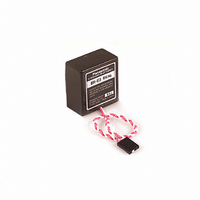BR-E3C3BCA Panasonic - BSG, BR-E3C3BCA Datasheet - Page 2

BR-E3C3BCA
Manufacturer Part Number
BR-E3C3BCA
Description
BATTERY PACK LITHIUM 6V W/LEADS
Manufacturer
Panasonic - BSG
Specifications of BR-E3C3BCA
Battery Type
Lithium
Voltage - Rated
6V
Capacity
1200mAh
Battery Cell Size
Pack with Leads
Number Of Cells
1
Termination Style
Wire Leads with Connector
Rechargeability
No
Size / Dimension
1.54" L x 0.87" W x 1.61" H (39.1mm x 22.1mm x 40.9mm)
Lead Free Status / RoHS Status
Lead free / RoHS compliant by exemption
Other names
BR-E3CBCA
P203
P203
batteries is D003, reactive. In either case, button cell batteries contain so little lithium that they never qualify as a
reactive hazardous waste. These batteries are safe for disposal in the normal municipal waste stream.
Disposal of large quantities of undischarged lithium batteries should be performed by permitted, professional disposal
firms knowledgeable in Federal, State and local hazardous materials and hazardous waste transportation and disposal
requirements. As always, households are exempt from the RCRA hazardous waste guidelines. In California, packages
that contain CR lithium coin cells and the Owners/Operating Instructions of products that contain CR lithium coin cells
must
www.dtsc.ca.gov/hazardouswaste/perchorate”. The effective date for this Perchlorate label was July 1, 2006 for non-
consumer products and January 1, 2007 for consumer products.
TRANSPORTATION
Effective October 1, 2008 all Panasonic lithium batteries, except for our BR-C, are not subject to the requirements
of the Department of Transportation (DOT) Subchapter C, Hazardous Materials Regulations if shipped in
compliance with 49 CFR 173.185 and Special Provision 188.
Effective January 1, 2011 all Panasonic lithium batteries can be shipped by air in accordance with International Civil
Aviation Organization (ICAO) 2011-2012 edition, Section II or International Air Transport Association (IATA) 51
edition, Section II, Packing Instructions (PI) 968 (Batteries), PI 969 (Batteries, packed with equipment) and PI 970
(Batteries, contained in equipment) as appropriate
Currently all Panasonic lithium batteries are regulated by the International Maritime Organization (IMO), 2010
edition under Special Provisions 188 and 230.
If you build any of our lithium cells into a battery pack, you must also assure that they are tested in accordance with
the UN Model Regulations, Manual of Test and Criteria. Part III, subsection 38.3, 5
Effective December 29, 2004, the DOT requires that the outside of each package that contains primary lithium
batteries, regardless of size or number of batteries, be labeled with the following statement: “PRIMARY LITHIUM
BATTERIES- FORBIDDEN FOR TRANSPORT ABOARD PASSENGER AIRCRAFT”. The labeling requirement
covers shipments via highway, rail, vessel or cargo-only aircraft and covers all shipments inside, into or out of the
US. The label must be in contrasting color and the letters must be 12 mm (0.5 in) in height for packages weighing
more than 30 Kg and 6 mm (0.25 in) in height for packages weighting less than 30 Kg.
If you plan on transporting any untested prototype battery packs contact your Panasonic Sales Representative for
regulatory information.
First Aid
If you get electrolyte in your eyes, flush with water for 15 minutes without rubbing and immediately contact a
physician. If you get electrolyte on your skin wash the area immediately with soap and water. If irritation continues,
contact a physician. If a battery is ingested, call the National Capital Poison Center (NCPC) at 202-625-3333
(Collect) or your local poison center immediately. Lithium coin batteries lodged in the esophagus should be
removed immediately. Leakage, chemical burns and perforation can occur within hours of ingestion.
General Recommendations
CAUTION: Risk of fire, explosion and burns. Do not recharge, crush, heat above 212
Fire Safety
In case of fire, you can use a Class “D” fire extinguisher or other smothering agent such as Lith-X, copper powder or dry
sand. If you use water, use enough to smother the fire. Using an insufficient amount of water will only make the fire
worse. Cooling the exterior of the batteries will help prevent rupturing. Burning of these batteries will generate toxic
and corrosive lithium hydroxide fumes.
information on fighting a lithium metal battery fire can be found in Guide 138 (Substances – Water – Reactive) of the
US DOT Emergency Response Guide.
017-11
Notice: The information and recommendations set forth are made in good faith and are believed to be accurate at the date of preparation.
include
the
following
Panasonic Industrial Company makes no warranty expressed or implied.
statement:
Fire fighters should use self-contained breathing apparatus.
“Perchlorate
1 of 2
Material
–
special
th
O
F (100
revised edition.
handling
O
C) or incinerate.
may
apply,
Detailed
st
See














